This ongoing pandemic has certainly accelerated numerous social and economic trends, such as working from home, online grocery shopping, and the build up in debt and deficits. It may have also hastened the arrival of a fairly prolonged period of U.S. dollar weakness, driven by some of the factors below:
Growth Differentials
Dollar strength in recent years has been supported by stronger economic growth in the US versus other developed economies, such as Japan and the European Union. However, the still-rising Covid-19 trajectory in the US versus the flatter trajectory in almost every other developed country indicates that the US growth contraction this year will be sharper than peers, and any ensuing recovery is likely to be weaker as well. As the chart below shows, lower US growth relative to the rest of the world (ROW) tends to be negative for the dollar, and vice-versa.

The weakness of the recovery will be accentuated by employment trends. US unemployment has risen more sharply vs. most developed countries because of weaker labor protections, as well as the extremely expensive, but poorly designed stimulus programs, such as the Paycheck Protection Program, that will likely fail to incentivize businesses to keep workers on their payroll. Persistently high unemployment and weaker social safety nets will hurt household consumption and weigh on US growth prospects over this year and next, if not longer.
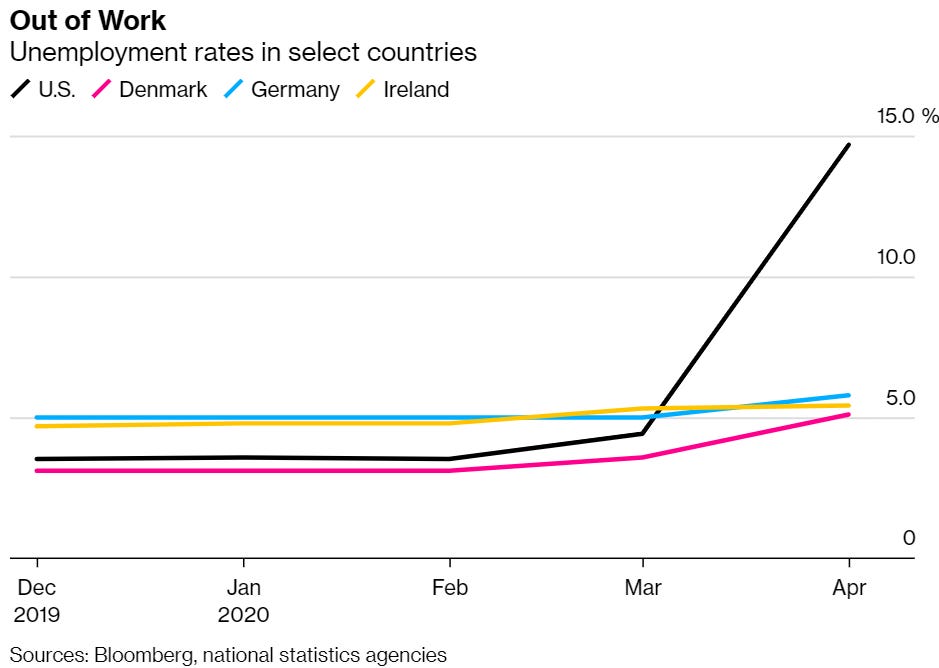
Twin Deficits
The US was already running an extremely large and irresponsible 5% budget deficit during the boom period entering the pandemic, which was extremely unusual and risky. Now, the necessary ramp up in stimulus spending will likely see the budget deficit surpass 15% of GDP this year. The US has also been running persistent Current Account deficits for a long time, and the Current Account deficit this year will likely come in around -5%. These sizable twin deficits are likely to weigh on the dollar.
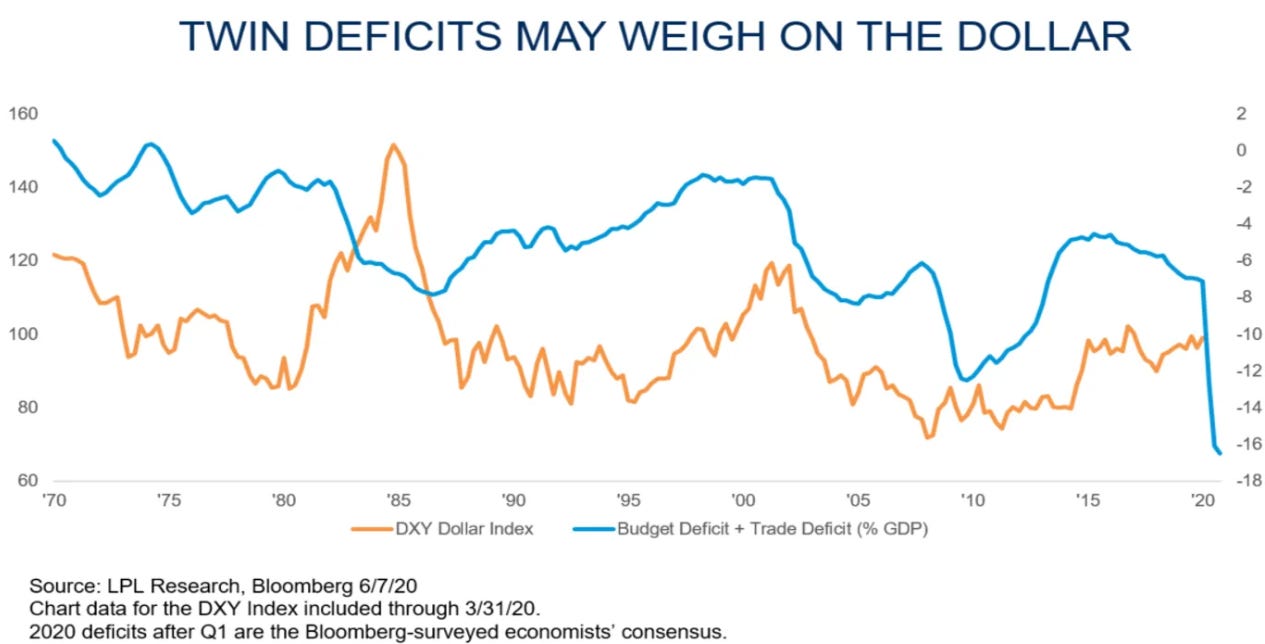
I should note that the dollar does not track the twin deficits perfectly and there have been periods where the dollar has strengthened in a rising twin deficit period. For example, twin deficits rose sharply following Reagan's tax cuts in 1981, but the dollar rose strongly between 1981-86. That being said, the dollar generally tends to track twin deficits quite well with a 2-year lag. This time, we are already starting at a high level for the fiscal deficit, that deficit has risen sharply, and all indications are that it will continue to rise explosively with our feckless politicians keenly aware that this is a election year.
Yield Differentials
US Treasuries have been among the highest yielding securities among the G-10 economies since 2016. That difference was accentuated by central bank policies over 2017 and 2018 as the US Federal Reserve embarked on rate hikes and short-lived quantitative tightening (Rest In Peace, my friend), while the Bank of Japan stayed pat and the European Central Bank mounted feeble and futile attempts to tighten its policy. However, in recent months, the Fed has slashed rates close to zero and has also indicated that it will not raise rates for at least two years. The dollar has now lost its sizable yield “buffer” and will be a relatively low yielding currency for the foreseeable future.
Europe
The dollar has benefited from a consistent series of European crises following the Global Financial Crisis of 2007-09, including debt crises in Greece and Portugal, the financial crisis in Cyprus, Brexit, the French elections, and the Italian elections. This scepter of Euro-area breakup risks has weighed on the euro, the dollar’s closest rival, and benefited the dollar.
However, the recent 750 billion euro breakthrough agreement reached in Brussels could usher in another period of euro strength, with breakup risks falling as the area edges closer to a true fiscal union, and joint European debt issuance providing competition to the U.S. dollar. It’s early days, but this development is one that I’m monitoring very closely.
Politics
Trump has consistently railed against the strength of the dollar (recent rhetoric notwithstanding) given his narrow view on trade and trade deficits. The current administration, like many administration before it, would welcome a weaker dollar to strengthen export competitiveness and the earnings of large multinational corporations, while continuing the tradition of paying lip service to a stronger dollar.
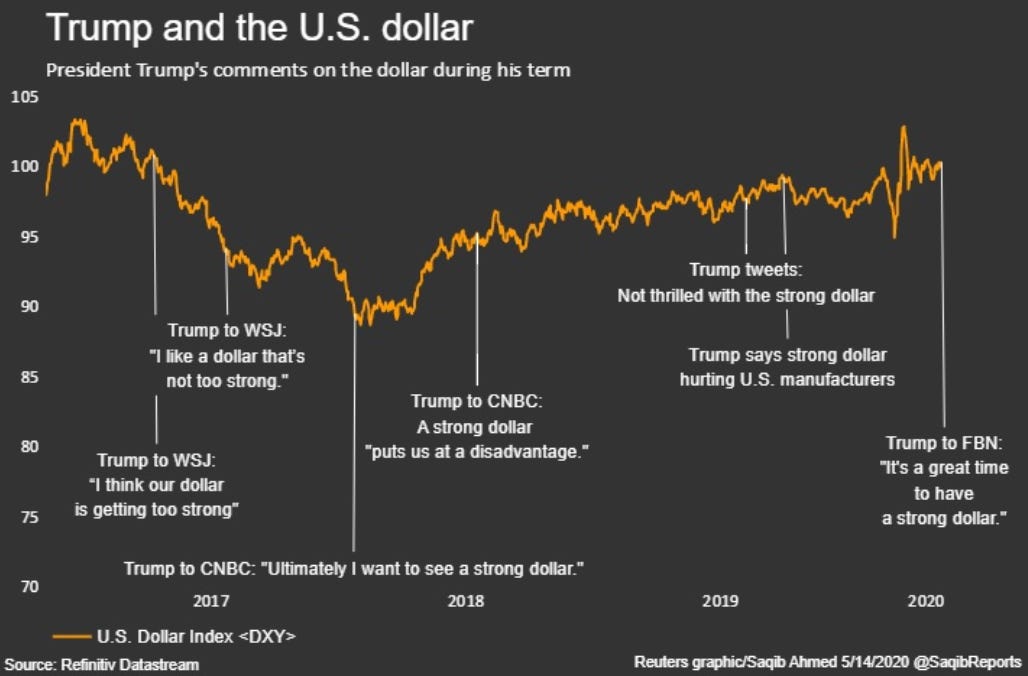
Valuation
These trends are not helped by the fact that the dollar appears overvalued relative to most currencies.
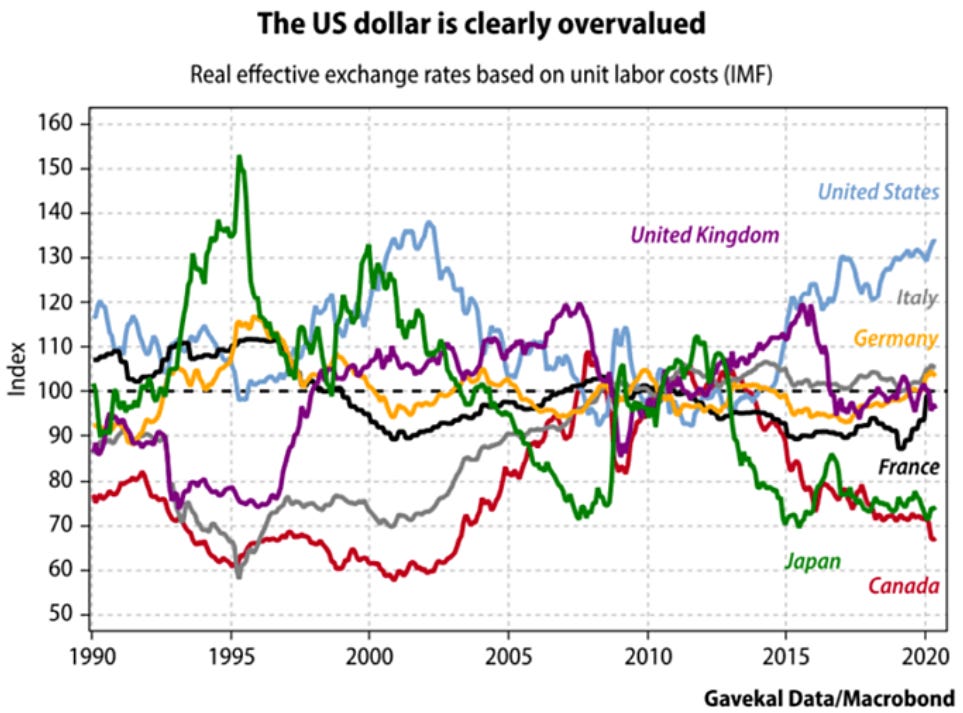
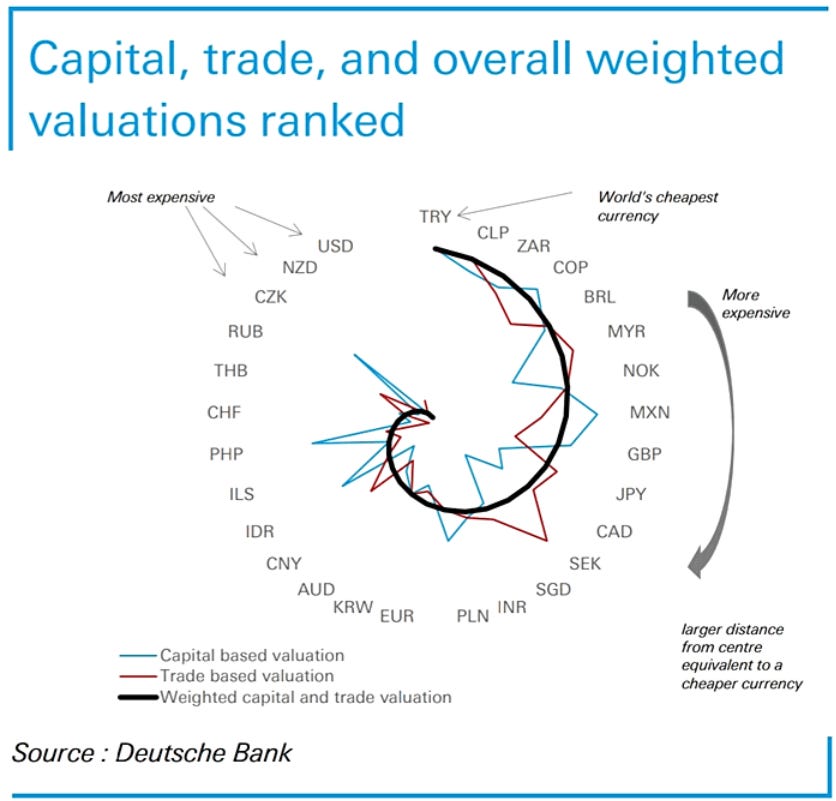
Overvaluation by itself does not mean that the dollar must depreciate in the near term. Indeed, valuation is a poor timing tool, but in the context of slowing relative growth, exploding deficits and the other factors described above, it does indicate that if the dollar were to correct, it could depreciate significantly (20%-30%).
Reserve Currency Status
What lends support to the dollar is that it remains the world’s reserve currency, without a serious competitor in sight. In times of crisis (“risk-off”), everyone reflexively flocks to safe-haven currencies like the dollar and the yen.
Despite competition from other currencies, the dollar still dominates international trade, transactions and central bank reserves. Indeed, as the BIS puts it, the dollar “is the foremost funding currency, half of all cross-border loans and international debt securities denominated in US dollars. Around 85% of all foreign exchange transactions occur against the US dollar. It is the world’s primary reserve currency, accounting for 61% of official foreign exchange reserves. Around half of international trade is invoiced in US dollars, and around 40% of international payments are made in US dollars.”

The likelihood that the dollar will be superseded by the Euro, the Japanese Yen, the UK pound, or the Chinese yuan is negligible at the present time. While the yuan’s share of global transactions is on the rise, China has a closed capital account and lacks deep, open, and liquid financial markets. Returning the world to a gold standard is highly unlikely because that would entail an extremely painful deleveraging for the credit-fueled, debt-laden global economy, and greatly reduce the flexibility that policymakers have come to depend on (and abuse). Bitcoin appears too new, too untested, too slow, and too restrictive (similar to a gold standard since it has a firm limit on the number of coins that can be mined). Perhaps, the most feasible scenario is a digital currency backed by a consortium of large and credible countries, but nothing like that appears to remotely be on the horizon.
Despite the likely continuation of the dollar hegemony for at least a few more years, a longer term risk is that the weaponization of the dollar by the Trump administration will weaken the role of the dollar as the world’s reserve currency. As we saw in the case of Iran, the US can punish a country or foreign banks that continue to do business with sanctioned officials by shutting them out of the international banking system, and in particular SWIFT, the international payments messaging system. This increases the urgency for countries to diversify out of the dollar system so that they aren’t held hostage by the actions of one country.
Overall, this period reminds me a lot of the 2002-07 period. We saw the Federal Reserve cut rates dramatically, from 5.25% to 1%, following the bursting of the tech bubble, and hold them for a number of years. The US fiscal and current account deficits exploded, and the dollar weakened significantly against the Euro and most other currencies. So, while the dollar is not likely to lose its reserve currency status anytime soon, that will likely not be enough to prevent the multi-year period of dollar weakness that appears to lie ahead…
Mack Row
Subscribe for free to get full access to the newsletter and website. No spam, no marketing lists.
I’m a Global Macro investor with years of investing experience at some of the largest hedge funds and institutional investment firms in the world. My goal is to educate people about investing and hopefully make them more thoughtful investors. I also want to help investors navigate their way through the treacherous investing environment of the 2020s.
Disclaimer: All the opinions expressed herein are mine alone, and do not in any way represent the views of my employer. I am not a licensed or registered sales representative, and am not making any solicitation to buy or sell securities.
